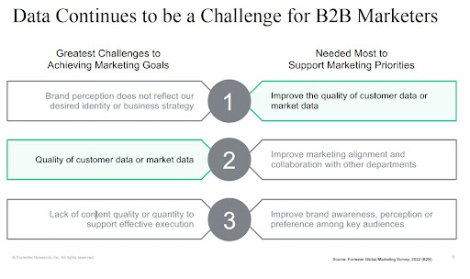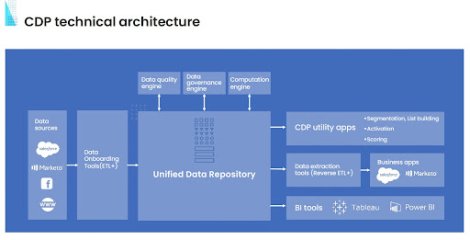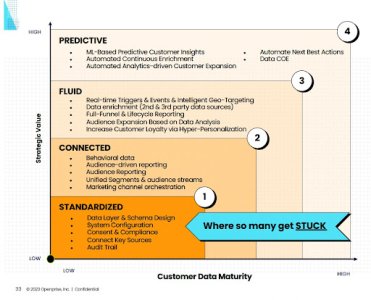
The ABCs of CDPs for B2Bs
With the falling storage and processing costs, almost every B2B can now afford to use data in some way to better understand and cater to its customers and improve its business. The question for B2B is no longer whether to adopt data-driven tools and methodologies but how to take their usage to the next level. For many B2Bs, the answer to that question brings them to the customer data platform, or CDP. The CDP has long been the gold standard for consumer businesses, particularly retailers, and is just now starting to gain traction with commercial businesses.
In our recent webinar Operationalize your customer data, we joined business leaders from Forrester and Shift Paradigm to discuss B2B CDP data platforms. In the webinar, this panel explored the market forces driving CDP for B2B adoption, its basic components, the technical architecture and requirements of the most common deployments, and the realistic expectations for success based on respective businesses’ data maturity levels.
Why CDP for B2B
For Katie Linford, principal analyst at Forrester, the interest in CDP is an extension of larger conversations about data and how companies can improve data utilization to make better decisions and satisfy higher customer expectations. For most B2Bs, the typical (yet far more complex) buyer’s journey has become similar to B2C in the way individual shoppers conduct their research and interact with their targeted brands or solutions. When done well, these orchestrated journeys appear seamless; behind the curtains, though, they require enormous effort and tons of accurate, up-to-date, real-time data. But with data depreciating at 25% per year, fulfilling this requirement is becoming increasingly challenging.

According to Forrester, improving data quality is a massive challenge for today’s B2B marketers. A strong data foundation is fundamental to what marketing and sales need to do today, yet most businesses can’t seem to get out of their own way to establish one. As a result, many see the B2B CDP data platform as the cure-all for their problems. While Katie cautions against this type of magical thinking, she does agree that a CDP, under the right circumstances, can be a powerful tool for unifying and cleansing data.
What marketers dream about
What can a CDP help accomplish once your data is good and accessible? Well, this is where the fun begins. It can continue to build out the profile, stitch together the known and unknown identities, enrich the profile with data from multiple sources, and create the complete customer view needed to construct meaningful segments. That brings us to the CDP’s second capability: wrangling big data. Scale and speed have always been one of the biggest challenges with big data, but now we have powerful technologies to distribute computing and quickly query any data type from any data storage. With these capabilities already on board, a CDP gives business users the speed and flexibility to generate insights and audiences on demand. Once we apply these to programs at scale and gather more data about our customers and prospects, we create the feedback loop needed for analysis and optimization. This is where a CDP provides the analytics needed to better understand the customer, their journey, and what is and isn’t working, as well as the tools to optimize and refine everything. Last but not least, a CDP provides the consent management needed for regulatory compliance while building the requisite level of trust.
CDP under the hood
Until now, we’ve talked abstractly about the technical capabilities required to address data quality and other market challenges. Thanks to Openprise Founder and CEO Ed King, we can now get under the hood and better understand the actual technologies and approaches B2B CDPs use to solve these problems. First are the integration and ETL (extract, transform, and load) tools used to clean, dedupe, and ensure accuracy. Next, they use a data-quality engine that can query the raw data and remove, clean, or fix it based on established rules or logic. Once the data is clean, CDPs layer on a governance engine to maintain that quality. The final step is the addition of logic or machine learning models and the use of a Python-based computational engine, for example, to manipulate and aggregate the data and extract the insights needed to make that data operational.

After the data is “good” and enriched—or, in the lexicon of Ed’s data operationalizing rubric, “yours”—it’s time to make it usable. As Ed mentions, there are three tools or technologies that CDPs use to help facilitate this transition. The first is a business intelligence (BI) tool, such as Tableau, PowerBi, or Domo, which allows you to “dig into your data and filter out whatever insights are useful to you.” The second typically involves a reverse ETL or data extraction tool that takes the data from your central repository and sends it to the systems accessible to the end users. Finally, you need the attribution, segmentation, lead scoring, and other utilities critical to operationalizing your data.
From composable CDPs to CDP-in-a-box: the options
Let’s look now at the primary builds, or packaged B2B CDP data platform options, available to commercial businesses. To start, the simplest is the “CDP-in-a-box,” or a single-vendor, fully integrated solution. These, as Ed explains, “tend to be very focused on top-of-funnel use cases like user activation and integration with your website and advertising platforms.” They typically come with good tools for lead scoring and segmentation, but they also have light data quality engines and limited flexibility or capability to handle the complexities of middle- or bottom-of-funnel motions.
To offset those limitations, businesses can combine the CDP-in-a-box with a RevOps platform, such as the Openprise RevOps Data Automation Cloud. In Openprise’s case, the RevOps platform is a full-stack data orchestration and automation cloud layer that supplements the CDP’s data quality and enrichment capabilities and provides the higher-level processing, instrumentation, and full-funnel coverage required for the advanced use cases B2Bs are looking to solve. This approach can also replace or abstract the complexity from many of the point solutions that make up the RevTech stack, thus limiting the tech debt and collateral damage done by various utility apps.
On the other end of the spectrum are composable CDPs, which are currently getting a lot of attention. This architecture typically comprises a data storage layer, such as a warehouse or data lake, plus a builder’s choice of middleware to take care of everything from data quality and governance to downstream operationalization. This approach is very dv-dependent and, unlike the CDP-in-a-box, is typically owned by IT, not operations. Like with the integrated solution, though, the composable architecture can be combined with a RevOps platform for a simpler framework and better results.
The composable-plus-RevOps-platform architecture can be an attractive option for enterprise businesses that need tighter integration with their BI tools and have the internal resources to support ongoing maintenance. This is especially true if they can replace the bulk of the middleware with a single platform, which makes it easier for the admin to monitor and support the processes. It also helps to have built-in, no-code recipes for data quality, funnel automation, enrichment, and anything else that makes it possible for marketing and sales ops to self-serve without IT intervention.
After spending more than 1,000 words hyping up the CDP and what it can do for commercial businesses, it’s a bit of a letdown to close with the reality that few B2Bs have the data maturity to support a CDP fully. Delivering this bad news was Natasha Ness, vice president of innovation and enablement at Shift Paradigm. In her practice, she works with a range of businesses across all levels of the data maturity scale, which begins with data standardization and ends at the top predictive level, or the “promised land,” as she calls it. The graphic below gives a visual idea of what this scale looks like—and where so many businesses get stuck.
Getting started
The reality is that the majority of businesses are still stuck at the first level, dealing with persistent data quality problems that make it difficult to get the maximum value from a CDP. The good news is that with the right approach and some guidance, a CDP can help build the necessary foundation and shepherd your business through the maturity curve. If you’re interested in learning more about B2B CDP data platforms and want to hear the specific strategies the presenters use to help their own clients shore up their data foundation, increase maturity, and get a CDP to work for their business goals, the whole talk is now available on demand.
Recommended resources















